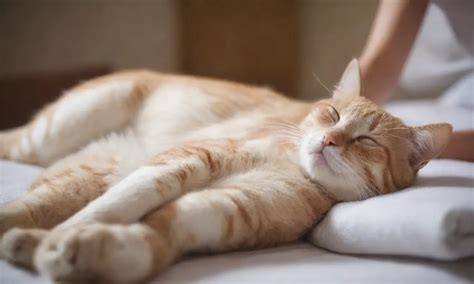Introduction
Cats are known for their independent nature, but they also crave affection and attention. As our understanding of feline behavior continues to grow, the benefits of cat massage and therapy are becoming increasingly recognized. In this article, we will explore the numerous advantages of these practices and how they can contribute to the overall well-being of your furry friend.

The Power of Touch for Cats
Touch is a fundamental sensory modality for cats. It plays a crucial role in communication, bonding, and stress reduction. Studies have shown that cats that receive regular massages experience decreased levels of stress and anxiety, improved circulation, and increased relaxation.
Cat Massage vs. Traditional Veterinary Care
While massage can be an excellent complementary therapy for cats, it is important to distinguish it from traditional veterinary care. Massage should not be used as a substitute for regular veterinary checkups or treatment of serious health conditions. However, it can provide additional benefits to a cat’s overall health and well-being.
Comparisons
| Veterinary Care | Cat Massage |
|---|---|
| Focuses on medical diagnosis and treatment | Promotes relaxation and well-being |
| Requires a licensed veterinarian | Can be performed by trained individuals |
| Essential for treating health issues | Can enhance overall quality of life |
Benefits of Cat Massage
Regular cat massages offer a wide range of benefits, including:
Physical Benefits
- Improved circulation
- Reduced muscle tension
- Increased mobility
- Enhanced skin and coat health
- Faster healing from injuries
Psychological Benefits
- Decreased stress and anxiety
- Increased relaxation
- Improved mood and behavior
- Reduced aggression
- Stronger bond between cat and owner
Additional Benefits
- May reduce the incidence of certain health problems, such as urinary tract infections and constipation
- Can provide comfort and support during end-of-life care
Types of Cat Massage
There are various types of cat massage techniques, each with its own unique benefits. Some common techniques include:
- Swedish massage: Long, gentle strokes that promote relaxation and reduce stress
- Deep tissue massage: Focuses on releasing tension in deep muscle layers
- Trigger point massage: Targets specific areas of muscle pain and tension
- Sports massage: Improves flexibility and range of motion
- Reflexology: Stimulates specific points on the feet to promote overall well-being
How to Give Your Cat a Massage
If you are interested in giving your cat a massage, it is important to approach the process gently and with patience.
Preparation
- Choose a quiet and comfortable location
- Make sure your cat is relaxed and receptive
- Use a light touch and avoid applying pressure
- Use massage oil or lotion to reduce friction
Techniques
- Start with gentle strokes along your cat’s back, head, and ears
- Gradually increase pressure and work deeper into the muscles
- Focus on areas where your cat may experience tension, such as the shoulders, neck, and hips
- Pay attention to your cat’s body language and adjust your technique as needed
Cat Therapy: A Holistic Approach
In addition to massage, cat therapy encompasses a wider range of holistic practices that promote feline well-being. These may include:
- Acupuncture
- Reiki
- Herbal remedies
- Behavioral counseling
Cat therapy can be beneficial in addressing various issues, such as anxiety, aggression, and chronic illness. It can also provide comfort and support to cats during stressful times, such as moving or the loss of a loved one.
Effective Strategies for Cat Massage and Therapy
To maximize the benefits of cat massage and therapy, consider the following strategies:
- Establish a regular routine: Regular massages and therapy sessions can help to maintain your cat’s well-being and prevent problems from developing.
- Find a qualified practitioner: If you are considering cat therapy, seek out a qualified practitioner with experience in feline care.
- Observe your cat’s body language: Pay attention to how your cat responds to massage and therapy. Adjust your techniques accordingly to ensure your cat’s comfort and well-being.
- Create a safe and comfortable environment: Provide a quiet and stress-free environment for your cat’s massage and therapy sessions.
- Use positive reinforcement: Reward your cat with treats or praise for good behavior during massage and therapy sessions. This will help to create a positive association with these practices.
Tips and Tricks for Cat Massage and Therapy
Here are some additional tips and tricks to make cat massage and therapy more effective:
- Use a warm washcloth or heating pad to relax your cat’s muscles before a massage.
- Use a soft brush or comb to remove excess hair and stimulate the skin before a massage.
- If your cat is resistant to massage or therapy, try distracting them with a toy or treat.
- Be patient and persevere. It may take time for your cat to adjust to massage and therapy.
Highlights and How to Stand Out
- Cat massage and therapy are becoming increasingly popular as people recognize the numerous benefits they offer.
- By understanding the unique needs of cats and using appropriate techniques, you can provide your furry friend with a relaxing and rejuvenating experience.
- By combining cat massage and therapy with other holistic practices, you can support your cat’s overall health and well-being.
Conclusion
Cat massage and therapy are powerful tools that can significantly enhance the lives of our feline companions. By providing regular massages, engaging in cat therapy, and following the tips outlined in this article, you can create a deeper bond with your cat and support their physical, psychological, and emotional well-being. As more research is conducted on the benefits of cat massage and therapy, we can expect to see these practices become an even more integral part of feline healthcare in the years to come.





















